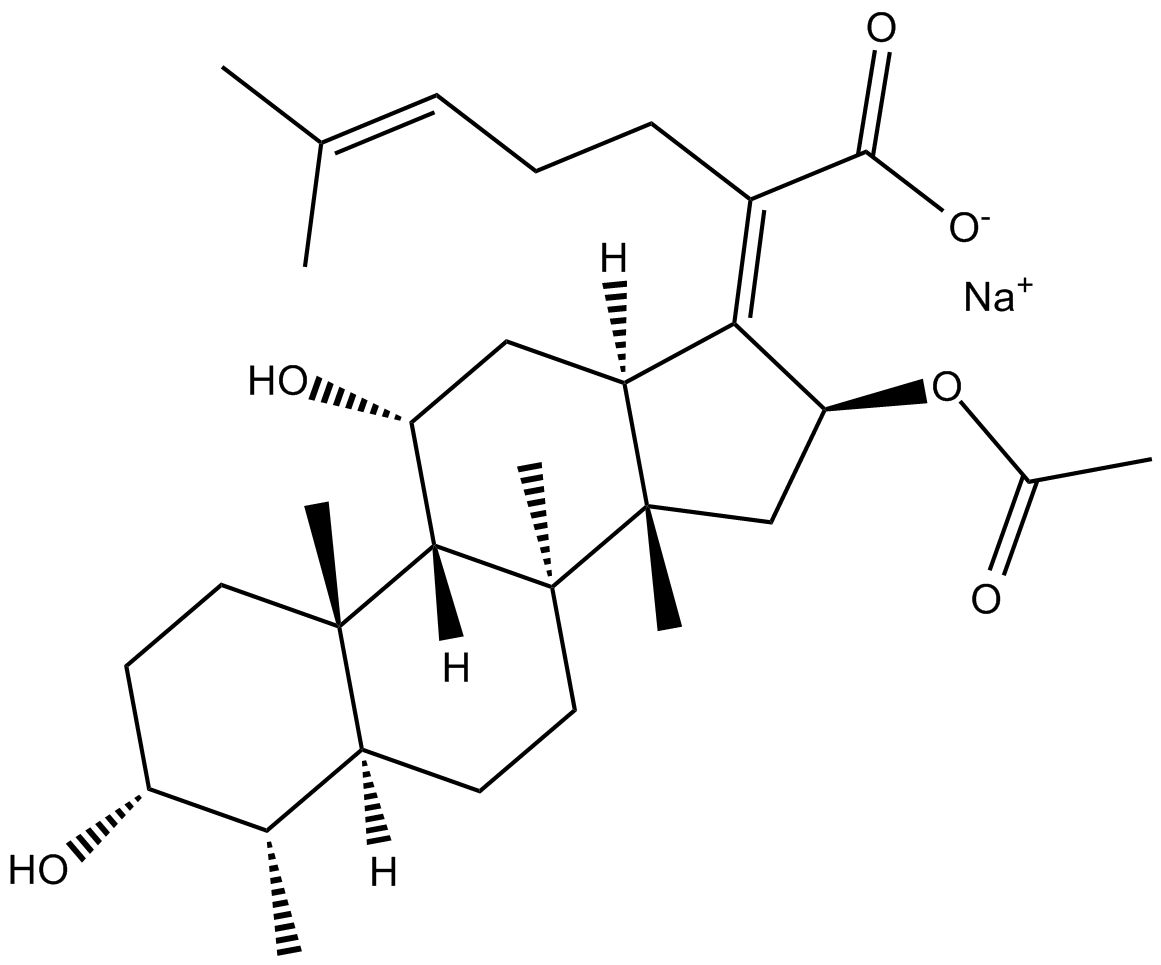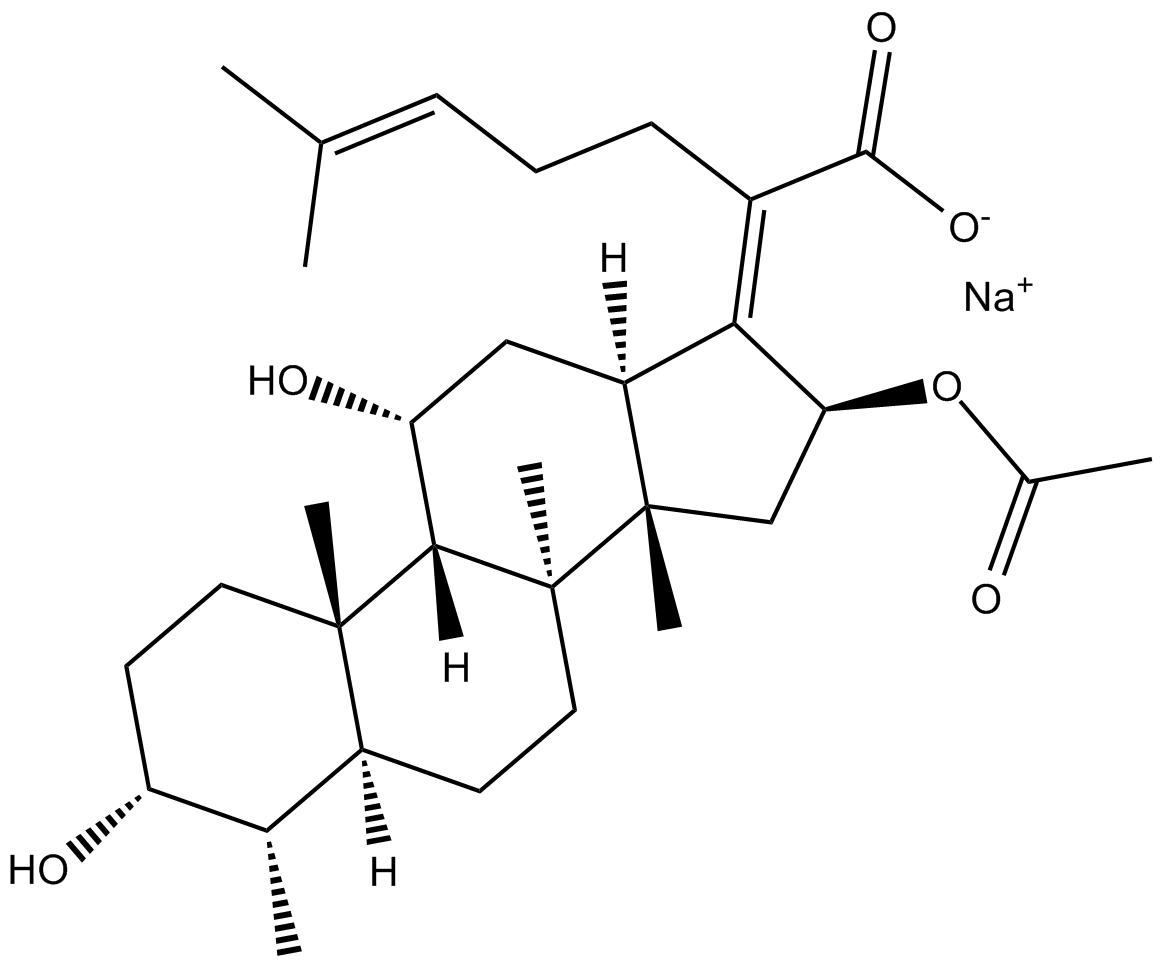Fusidic Acid (sodium salt)
IC50: ~10-200 μM for the translocation function of the elongation factor EF-G
Fusidic acid is a steroidal antibiotic.
Fusidic acid was identified as a steroidal antibiotic produced by the fungus Fusidium conccineum.
In vitro: Resistance to fusidic acid in S. aureus strains was selected and mutations were identified in the fusA gene, which encodes EF-G. Fusidic acid could not bind to free EF-G, but rather to EF-G GTP in the complex with ribosome, suggesting that the antibiotic required a specific conformation of EF-G for binding. Biochemically, fusidic acid permited ribosome-stimulated GTP hydrolysis by EF-G, but prevented the associated conformational changes in EF-G, and therefore prevented EF-G turnover by stabilizing EF-G GDP on the ribosome. Fusidic acid did not work on eukaryotes, but sordarin was considered to similarly act on yeast EF2 and was used to assemble EF2-80S yeast ribosome complexes for cryo-EM analysis [1].
In vivo: Animal study found that fusidic acid sodium salt was well absorbed after oral administration and it could significantly reduce the diabetes incidence in BB rats. Fusidic acid sodium salt substantially accumulated more in female rats which might refult from the steroid structure of fusidin [2].
Clinical trial: Fusidic acid was first introduced into clinical use in 1962 mainly for the treatment of Staphylococcus aureus infections [1].
References:
[1] Wilson, D. N. The A-Z of bacterial translation inhibitors. Crit. Rev. Biochem. Mol. Biol. 44(6), 393-433 (2009).
[2] Hageman I, Buschard K. Antidiabetogenic effect of fusidic acid in diabetes prone BB rats: a sex-dependent organ accumulation of the drug is seen. Pharmacol Toxicol. 2002 Sep;91(3):123-8.
| Storage | Store at -20°C |
| M.Wt | 538.7 |
| Cas No. | 751-94-0 |
| Formula | C31H47O6·Na |
| Synonyms | SQ 16,360 |
| Solubility | ≥14.15 mg/mL in H2O; ≥31.7 mg/mL in EtOH; ≥52.4 mg/mL in DMSO |
| Chemical Name | (4α,8α,9β,13α,14β)-16β-(acetyloxy)- 3α,11α-dihydroxy-29-nordammara-17Z(20),24-dien-21-oic acid, monosodium salt |
| SDF | Download SDF |
| Canonical SMILES | O[C@@H]1CC[C@@]2(C)[C@](CC[C@@]3(C)[C@@]2([H])[C@H](O)C[C@]4([H])[C@]3(C)C[C@H](OC(C)=O)/C4=C(C([O-])=O)/CC/C=C(C)/C)([H])[C@@H]1C.[Na+] |
| Shipping Condition | Small Molecules with Blue Ice, Modified Nucleotides with Dry Ice. |
| General tips | We do not recommend long-term storage for the solution, please use it up soon. |
| Animal experiment [1]: | |
|
Animal models |
Diabetes Prone BB Rats |
|
Dosage form |
339 mg/day for male rats and 245 mg/day for male rats in the chow; 200 mg/day for male rats and 163 mg/day for female rats in the water. |
|
Application |
Animal studies have found that fusidic acid sodium salt is well absorbed after oral administration and can significantly reduce the incidence of diabetes in BB rats. Fusidic acid sodium salt accumulates in female rats in large quantities, possibly derived from the steroid structure of fusidin. |
|
Other notes |
Please test the solubility of all compounds indoor, and the actual solubility may slightly differ with the theoretical value. This is caused by an experimental system error and it is normal. |
|
References: [1]. Hageman I, Buschard K. Antidiabetogenic effect of fusidic acid in diabetes prone BB rats: a sex-dependent organ accumulation of the drug is seen. Pharmacol Toxicol. 2002 Sep;91(3):123-8. doi: 10.1034/j.1600-0773.2002.910306.x. PMID: 12427112. |
|
Quality Control & MSDS
- View current batch:
Chemical structure








